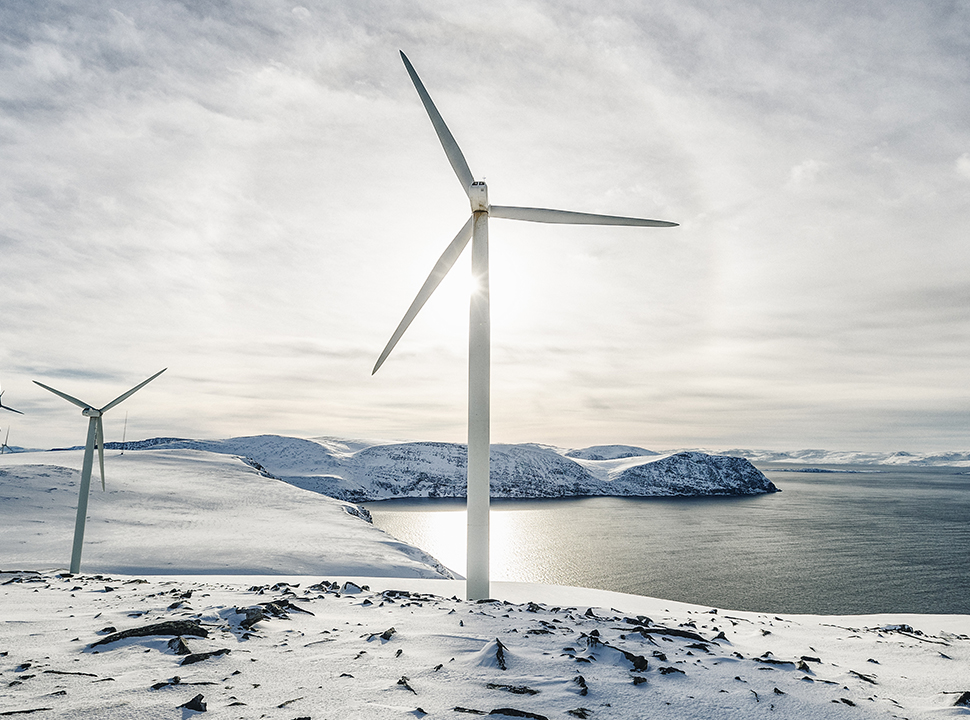Engineers Set New Record for Freezing Point
Engineers Set New Record for Freezing Point


How low can you go and keep from turning to ice? A recent advance could help wind turbine performance in cold weather.
What’s the freezing point of water? Forget about 32 degrees Fahrenheit. That’s merely the temperature at which water freezes under certain conditions. In other conditions, it can remain liquid far below that supposed threshold. That’s why many animals can survive the winter and why clouds can pass through so-called freezing temperatures without necessarily turning to snow or hail.
For years, the lower limit for liquid water before turning to ice in laboratory conditions was -36 °F. Below that, scientists have believed for some time now, droplets, hibernators, and clouds stand no chance of avoiding crystallization.
Now the absolute freezing temperature of water has dropped even lower. “The initial idea was just to go to the smallest scale and see how water is behaving,” said Hadi Ghasemi, a professor of mechanical engineering at the University of Houston in Texas and co-author of the paper “Freezing of few nanometers water droplets,” which appeared in Nature Communications in November 2021. What Ghasemi and his colleagues found was that water could be brought to -47 °F without freezing.
“We surrounded these nanodroplets with materials with different stiffnesses—we started with a hard material and then reduced the shear modulus stepwise,” Ghasemi said. “We found that as you make the surface softer and softer, the freezing point is going to drop further.”
In short, the more a droplet is cuddled, the lower it can go with crystalizing.
Exactly why such a soft embrace bends the laws of physics is not yet known. “That’s a big mystery,” Ghasemi said. “It’s still an open question.”
Regardless of the explanation, there are many potential applications for such a freeze-resistant water. Airplanes wings, for instance, may no longer need to be doused in deicing fluids. Instead, they could be covered in a coating with many tiny deformations. Such deformation could, perhaps, be tuned to match whatever weather an aircraft might face.
More about temperature extremes: Cryogenic Robotic Arm for Lunar Missions
Similarly, ice accumulation on the blades of wind turbines can reduce power production by as much as 80 percent. Heating elements can curb the problem, but their use is energy intensive. A coating would keep blades free of ice without using additional energy.
“You need curvature at the interface—you don’t need it for the whole droplet,” Ghasemi said. “If you have high curvature at the interface, you are done, you are good to go.”
Cryopreservation is another area where the ability to go cold without freezing would be a major boon. The expansion that comes with the crystallization of water can mean the destruction of any biological elements. Ghasemi’s droplets were two or three nanometers in diameter, but they up to 50 microns long, so future cryopreservation needn’t be limited to spheres. With the soft nanostructures, long water droplets, and the biology that depends on them, can be brought to -40 °F, and kept there without being damaged.
“Water is everywhere, ice is everywhere,” Ghasemi said. “When you are working on this edge of science you have a lot of ideas. Most of them will fail, but some of them are really good.”
Michael Abrams is a science and technology writer based in Westfield, N.J.
For years, the lower limit for liquid water before turning to ice in laboratory conditions was -36 °F. Below that, scientists have believed for some time now, droplets, hibernators, and clouds stand no chance of avoiding crystallization.
Now the absolute freezing temperature of water has dropped even lower. “The initial idea was just to go to the smallest scale and see how water is behaving,” said Hadi Ghasemi, a professor of mechanical engineering at the University of Houston in Texas and co-author of the paper “Freezing of few nanometers water droplets,” which appeared in Nature Communications in November 2021. What Ghasemi and his colleagues found was that water could be brought to -47 °F without freezing.
More like this: The Question of Winterizing Wind Turbines
“We surrounded these nanodroplets with materials with different stiffnesses—we started with a hard material and then reduced the shear modulus stepwise,” Ghasemi said. “We found that as you make the surface softer and softer, the freezing point is going to drop further.”
In short, the more a droplet is cuddled, the lower it can go with crystalizing.
Exactly why such a soft embrace bends the laws of physics is not yet known. “That’s a big mystery,” Ghasemi said. “It’s still an open question.”
Regardless of the explanation, there are many potential applications for such a freeze-resistant water. Airplanes wings, for instance, may no longer need to be doused in deicing fluids. Instead, they could be covered in a coating with many tiny deformations. Such deformation could, perhaps, be tuned to match whatever weather an aircraft might face.
More about temperature extremes: Cryogenic Robotic Arm for Lunar Missions
Similarly, ice accumulation on the blades of wind turbines can reduce power production by as much as 80 percent. Heating elements can curb the problem, but their use is energy intensive. A coating would keep blades free of ice without using additional energy.
“You need curvature at the interface—you don’t need it for the whole droplet,” Ghasemi said. “If you have high curvature at the interface, you are done, you are good to go.”
Cryopreservation is another area where the ability to go cold without freezing would be a major boon. The expansion that comes with the crystallization of water can mean the destruction of any biological elements. Ghasemi’s droplets were two or three nanometers in diameter, but they up to 50 microns long, so future cryopreservation needn’t be limited to spheres. With the soft nanostructures, long water droplets, and the biology that depends on them, can be brought to -40 °F, and kept there without being damaged.
“Water is everywhere, ice is everywhere,” Ghasemi said. “When you are working on this edge of science you have a lot of ideas. Most of them will fail, but some of them are really good.”
Michael Abrams is a science and technology writer based in Westfield, N.J.






